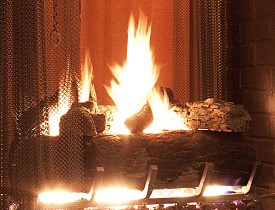What You Need to Know About Gas Fireplaces
 Fireplaces have evolved right along with the American home. Colonial houses were literally built around a massive central hearth and chimney, Victorians had small coal-burning fireplaces for heating rooms, and nearly every post-war 20th-century home had a squarish brick hearth anchoring its family room. Today, gas fireplaces are the standard for both new homes and remodels, and they represent a much bigger evolutionary change in heating systems than a new type of fuel.
Fireplaces have evolved right along with the American home. Colonial houses were literally built around a massive central hearth and chimney, Victorians had small coal-burning fireplaces for heating rooms, and nearly every post-war 20th-century home had a squarish brick hearth anchoring its family room. Today, gas fireplaces are the standard for both new homes and remodels, and they represent a much bigger evolutionary change in heating systems than a new type of fuel.
More Than Just Fake Logs
Traditional wood-burning fireplaces won't be completely extinct for a long time, if ever, but there's an armload of reasons why many folks are switching to natural gas. Some of the main benefits:
- convenience
- instant startup
- no tending
- no mess
- no expensive wood to buy each year
- no municipal burning restrictions
- low maintenance (no chimney sweep)
- energy efficiency (50-99% efficient compared to 10-30% for wood)
- clean burning (wood fireplaces add to smog problems, which is why they're banned in many cities)
But the clincher for most people is the easy installation—a gas fireplace can go pretty much anywhere you can run wiring, a gas line and a small metal chimney.
Types of Gas Fireplaces
The three main types of gas fireplaces are log sets, inserts and built-ins. Log sets and inserts convert traditional masonry fireplaces to gas. A log set is a kit with a burner, grate and logs that sits inside the old fireplace, typically using the chimney for venting. Inserts are self-contained units that slip into a firebox. They often have dedicated venting and can offer the same heating and efficiency features as a built-in. Built-ins are freestanding appliances that you enclose with framing and wall finishes. Built-ins are the most versatile type and range from large standard units that mimic traditional fireplaces to double-sided through-the-wall units to futuristic models that border on wall art.
Venting Options
While you can vent some gas fireplaces through an existing masonry chimney or a new B-vent chimney (one that does exhaust only), this negates much of the efficiency and room heating benefits of gas. Most of the fire's heat goes up the chimney, along with the room's warm air.
At the other end of the spectrum is the no-vent option, possible only with "vent-free" fireplaces. These are highly efficient because all the heat stays in the house, but no matter how efficiently you burn gas, it still gives off carbon monoxide and water vapors. You'll have to decide whether no-vent is a good idea for your home; manufacturers say the system is perfectly safe, yet many building science experts believe it degrades indoor air quality and is potentially hazardous.
That leaves the best all-around option: direct venting. This uses a special metal duct that pulls fresh air from outdoors to feed the gas fire with oxygen and then sends the fire's exhaust out through a separate chamber. Because the front of the fireplace is sealed (usually with glass), there's no loss of warm room air, and all of the bad stuff from the fire goes outdoors.
Installation
Most built-in gas fireplaces with direct venting are "zero-clearance," meaning they can be enclosed with wood framing and other standard construction materials, although offsets or heat shields may be required for some parts. Vent ducts typically run from the top of the unit and out through the nearest exterior wall, but many other configurations are possible. Most of the installation is doable for a handy homeowner. However, you should hire a pro to handle the gas and electrical hookups and install or at least inspect the vent duct to make sure it's safe. The wall above and around the unit can be finished with trim, paint, tile, faux stone, you name it.
Good Features to Have
If you're springing for a new fireplace, you might as well spend a little more for the best features: variable flame (adjust it up or down as desired), electronic ignition (no wasteful pilot light; best with battery backup) and circulating fan (heats room more evenly and efficiently than passive radiant heating). Additional bells and whistles include thermostat control, which automatically adjusts the flame based on the room temperature, and remote operation, for the ultimate in couch-potato bliss.
Philip Schmidt writes for Networx.com.
Updated January 10, 2018.
Looking for a Pro? Call us (866) 441-6648

Heating & cooling Average Costs
HVAC Contractors Experiences

Tree Removal So Fast And Efficient It Didn’t Even Wake Our Newborn

Leaf Removal This Year, More Landscape Work Next Summer



